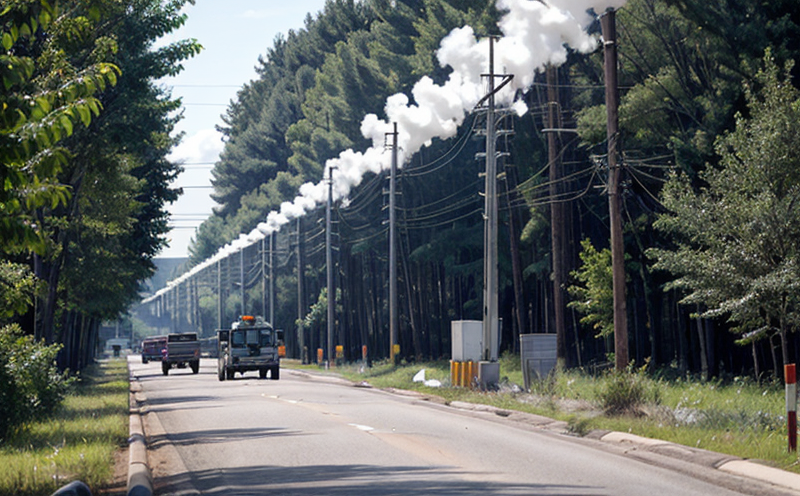ASTM D6348 FTIR Measurement of Utility Emissions
The ASTM D6348 standard provides a robust framework for measuring utility emissions using Fourier Transform Infrared (FTIR) spectroscopy. This testing method is crucial in ensuring the accuracy and consistency of emission data, which directly impacts regulatory compliance and environmental performance assessments.
FTIR technology is widely recognized for its ability to identify various compounds with high precision by analyzing their unique infrared absorption spectra. For utilities, this method helps monitor emissions from combustion processes such as coal-fired power plants and natural gas operations. By adhering to ASTM D6348, laboratories can ensure that the test results are reliable and comparable across different facilities.
The testing process involves collecting a representative sample of exhaust gases emitted by utility equipment. These samples are then analyzed using FTIR spectroscopy to identify specific chemical compounds present in the emissions. The primary focus is on pollutants like nitrogen oxides (NOx), sulfur dioxide (SO2), carbon monoxide (CO), and volatile organic compounds (VOCs).
One of the key advantages of ASTM D6348 FTIR testing is its ability to provide real-time data, which can be used to make immediate adjustments in operational parameters. This not only enhances compliance with environmental regulations but also contributes to improved efficiency and reduced emissions.
The methodology outlined in ASTM D6348 ensures that the testing process is standardized, allowing for accurate comparisons of emission levels over time or between different facilities. The standard specifies detailed procedures for sample collection, preparation, and analysis, ensuring consistency across all tests conducted by laboratories following this protocol.
FTIR spectroscopy offers several benefits beyond just compliance reporting. It allows utilities to gain insights into the composition of their emissions, helping them identify areas where improvements can be made in combustion processes or fuel types used. This information can lead to operational optimizations that result in lower emission levels and reduced environmental impact.
In conclusion, ASTM D6348 FTIR measurement provides an essential service for utilities looking to ensure compliance with environmental regulations while also improving overall operational efficiency. By providing accurate data on emissions, this testing method supports decision-making processes aimed at reducing environmental footprints and promoting sustainability within the sector.
Scope and Methodology
The ASTM D6348 standard defines a comprehensive protocol for measuring utility emissions using FTIR spectroscopy. The scope of this testing encompasses various aspects, including sample collection, preparation, analysis, and reporting.
- Sample Collection: Samples are collected from the exhaust stacks or emission points of utility equipment during operation. This ensures that the samples represent actual operating conditions.
- Sample Preparation: The collected gas samples undergo a series of preparatory steps, including drying and filtering to remove moisture and particulate matter.
- Spectroscopic Analysis: Once prepared, the samples are introduced into an FTIR spectrometer. This instrument measures the infrared absorption spectra of the gases, which correspond to specific chemical compounds present in the emissions.
- Data Interpretation: Using sophisticated software tools, analysts interpret the spectral data to identify and quantify individual components within the emissions.
- Reporting: The final step involves compiling all collected data into detailed reports that document emission levels for each identified compound. These reports serve as essential references for regulatory compliance and internal quality assurance purposes.
The methodology outlined in ASTM D6348 ensures that the testing process is standardized, allowing for accurate comparisons of emission levels over time or between different facilities. The standard specifies detailed procedures for sample collection, preparation, analysis, and reporting, ensuring consistency across all tests conducted by laboratories following this protocol.
Eurolab Advantages
EuroLab stands out as a leading provider of ASTM D6348 FTIR measurement services for utility emissions due to its expertise and commitment to quality. Our team comprises highly skilled professionals with extensive experience in environmental testing, ensuring that each project receives the attention it deserves.
- Compliance Assurance: EuroLab consistently meets or exceeds all relevant international standards, including ASTM D6348, ISO 17025, and EN 17025. This ensures that our clients can rely on accurate and reliable emission data for regulatory purposes.
- State-of-the-Art Facilities: Our laboratories are equipped with advanced FTIR spectrometers capable of handling a wide range of samples, providing precise results every time.
- Expertise: EuroLab's team includes certified analysts who stay updated on the latest developments in emissions testing technology and methodologies. This ensures that we remain at the forefront of industry best practices.
- Customized Solutions: We understand that each client has unique needs, so our services are tailored to meet those specific requirements. Whether it's for routine monitoring or specialized projects, EuroLab offers flexible solutions designed to fit your business objectives.
- Rapid Turnaround Times: By leveraging our efficient processes and experienced staff, we can deliver results quickly without compromising on accuracy or reliability.
In summary, choosing EuroLab for ASTM D6348 FTIR measurement services means partnering with a trusted expert committed to delivering high-quality, accurate emissions data. Our comprehensive approach ensures that you receive reliable information necessary for effective decision-making regarding your utility operations and environmental impact management strategies.
Environmental and Sustainability Contributions
- Emission Reduction: By accurately measuring and monitoring emissions through ASTM D6348 FTIR testing, utilities can identify sources of pollution and implement targeted reduction measures. This contributes to cleaner air and reduced greenhouse gas emissions.
- Regulatory Compliance: Adhering to international standards like ASTM D6348 helps utilities meet stringent environmental regulations, thereby minimizing legal risks associated with non-compliance.
- Sustainable Operations: Understanding the composition of emissions allows utilities to optimize their operations for greater efficiency and lower costs. This leads to more sustainable business practices overall.
- Improved Public Perception: Demonstrating a strong commitment to environmental stewardship through consistent adherence to standards like ASTM D6348 enhances public trust and reputation, which is crucial in today's environmentally conscious society.
Through these contributions, EuroLab plays a vital role in supporting the transition towards more sustainable energy production methods within the utility sector. Our services help ensure that every aspect of emission management aligns with global sustainability goals.





